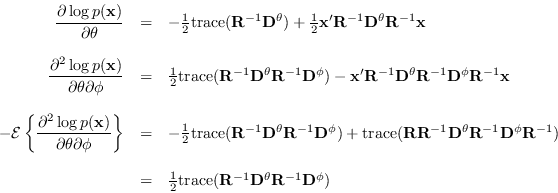Next: CR bound analysis of Up: ARMA Modeling Previous: ARMA parameter estimation Contents
R=toeplitz(r(1:N)); lpx = -N/2*log(2*pi)-.5*log(det(R)) - .5*x'*inv(R)*x);We note that the derivative of lpx with respect to a scalar parameter
Ri=inv(R); lpx_theta = -.5*trace( Ri * D ) + .5 * x'*Ri*D*Ri*x;where D is
D=toeplitz(d(1:N)); lpx_theta = -.5*trace( Ri * D ) + .5 * x'*Ri*D*Ri*x;
We can write r in terms of the ARMA parameters in a simple form if we make use of the
fact that for a stable ARMA process, r must eventually decay to zero.
For large enough ![]() ,
,
![]() for
for ![]() . Then, we can treat r as a circular ACF,
the inverse DFT of a circular power spectrum of size
. Then, we can treat r as a circular ACF,
the inverse DFT of a circular power spectrum of size ![]() .
Thus, the values of the circular PSD of length
.
Thus, the values of the circular PSD of length ![]() computed using (10.9) will be the same as the true PSD at discrete frequencies.
Therefore, the circular ACF will match the first
computed using (10.9) will be the same as the true PSD at discrete frequencies.
Therefore, the circular ACF will match the first ![]() values of the true ACF.
Let rho be the length-
values of the true ACF.
Let rho be the length-![]() circular PSD. If,
circular PSD. If,
r = real(ifft(rho));then the first
d = real(ifft(rho_theta));where rho_theta is the vector of derivatives of the elements of rho with respect to parameter theta. These derivatives are
d = real(ifft(rho_theta)); D=toeplitz(d(1:N)); Ri=inv(R); lpx_theta = -.5*trace( Ri * D ) + .5 * x'*Ri*D*Ri*x;The problem with this approach is the necessity of computing and storing the
y = toepsolve(r,x); % y = inv(toeplitz(r)) * x; d = real(ifft(rho_theta)); D=toeplitz(d(1:N)); H = toepsolve(r(1:N),D); lpx_theta = -.5*trace(H) + .5 * y'*D*y;where x=toepsolve(r,b); uses the Levinson algorithm to solve the general symmetric toeplitz system b = toeplitz(r)*x; for x. Note that if B is a matrix, X=toepsolve(r,B); will solve the problem for each column of B in turn. Since we still need to store H and D unecessarily (we need only the trace of H and D is Toeplitz), it makes sense to code up a special function
function L=toep_special(B,r,y,N); % solves the problem: % % for i=1:size(B,2), % D=toeplitz(B(1:N,i)); % H = inv(R) * D; % L(i) = -.5*trace(H) + .5 * y'*D*y; % end; % where % R = toeplitz(r(1:N)); % y = inv(R) * x; % % for each column of B without having to store R, H, or D, % or take the inverse of a matrix!!! % If each column of B is the derivative of the power spectrum % with respect to a different parameter, and r is the ACF, % and x is the raw data, then the output are the derivatives of the log-PDF % lpx = -N/2*log(2*pi)-.5*log(det(R)) - .5*x'*inv(R)*x); % with respect to the parametersIn summary, we can compute the exact derivatives of (10.6) with respect to the ARMA parameters as follows:
A=fft([a(:); zeros(2*L-P-1,1)]);
B=fft([b(:); zeros(2*L-Q-1,1)]);
A2=msq(A);
B2=msq(B);
h = B2./A2;
rho = sig2 * h;
r = real(ifft(rho));
E=exp(-1i*2*pi/N/2*[0:2*N-1]' * [0:max(P,Q)]);
[y,ldetR] = toepsolve(r(1:N),x(1:N),N); % y = R \ x;
Rho_a = -2 * sig2 * real( repmat(h./A,1,P) .* E(:,2:P+1) );
Rho_b = 2 * sig2 * real( repmat(h./B,1,Q) .* E(:,2:Q+1) );
R_a = real(ifft(Rho_a));
R_b = real(ifft(Rho_b));
da = toep_special(R_a(1:N,:),r(1:N),y(1:N),N);
db = toep_special(R_b(1:N,:),re(1:N),y(1:N),N);
Note that Rho_a be the matrix where column Rho_a(:,m) is rho_theta for
parameter
rho_sig = h;
r_sig = real(ifft(rho_sig));
dsig = toep_special(r_sig(1:N),r(1:N),y(1:N),N);
however, a more compact form can be shown to be
dsig = -.5*N/sig2 + .5 * y(1:N)'*x(1:N)/sig2;
The second derivatives may also be obtained and the Fisher's information
computed. Let ![]() ,
, ![]() be two general spectral parameters. Then
be two general spectral parameters. Then

H_theta = toepsolve(r,D_theta);We can simplify matters if we notice that for two matrices A, B, we have trace( A * B) is the same as sum( C(:) ) where C= A .* B';. The function toep_fim efficiently computes
function Q=toep_fim(B,r,L); % solves the problem: % % R = toeplitz(r); % for i=1:size(B,2), % Di=toeplitz(B(:,i)); % for j=1:size(B,2), % Dj=toeplitz(B(:,j)); % Q(i,j) = .5*trace(inv(R)*Di*inv(R)*Dj); % end; % end; %See software/pdf_arma_exact.m for details.